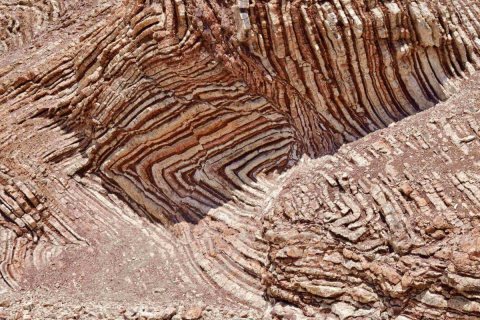
Geological time, usually seen as a complex system of eras, periods, and epochs considered through layers of rock, may actually follow a simple, unifying pattern. A new study, led by McGill University physicist Shaun Lovejoy, shows that the boundaries dividing the Earth's most important historical events, such as mass extinctions and major climate shifts, follow a fractal pattern: self-similar and statistically consistent across scales of millions to hundreds of millions of years.
The discovery could have major implications for how researchers reconstruct the Earth's deep past and how they anticipate the future.
"These boundaries are the scaffolding that is used to calculate the time scale of practically all the data we have from the ancient past," said Lovejoy. "If we don't account for the way these boundaries cluster in time, it introduces biases in our understanding of past climate, ecosystems and planetary changes."
The study, published in Earth and Planetary Science Letters, analyzed global and regional geological time series, including the internationally recognized Geological Time Scale (GTS2020). The team quantified the timing of boundary events over the past 541 million years - a period known as the Phanerozoic Eon - and found that their distribution wasn't just hierarchical in a qualitative sense, but quantitatively fractal. This means that no single characteristic timescale defines the spacing between these major events.
"You've got all these eras and epochs and periods and eons, but actually there isn't a characteristic time involved," Lovejoy said. "What we found is that you can explain these major geological divisions with a kind of symmetry - what's called scale symmetry in time."
"The most exciting part of the revealed pattern is that geological time boundaries, despite their differences in the proximal causes, follow a single scaling law," said Andrej Spiridonov, co-author of the study and Professor in the Department of Geology and Mineralogy at Geosciences Vilnius University.
Re-thinking historic climate and extinction events
The team built a statistical model to simulate how such boundary events accumulate over time. The model shows that although the events appear to follow no particular rule, they follow a deeper pattern of hierarchical clustering. This insight helps explain why some intervals in the rock record are densely packed with events while others contain long gaps.
The findings also point to two distinct phenomena the researchers call "Sadler effects." The first, already known, is the resolution effect: geological records become less complete at finer time scales. The second, newly identified in this study, is the length effect: over longer time intervals, the record becomes increasingly distorted. In other words, not only are there more missing pieces in older layers of rock, but even the way we divide time can introduce systematic biases.
"If you don't take the fractal structure into account, your interpretation of how things change over time will be biased," said Lovejoy. "That becomes really important when you're analyzing climate shifts, biodiversity patterns or extinction events based on core samples."
By better understanding the structure of deep time, researchers hope to improve methods for dating and interpreting paleoclimate and paleoenvironmental records. The next steps, Lovejoy said, include refining the model and developing correction techniques that can be applied to large-scale geological datasets.
"There is information in the past which can give us skill to try and work out what will happen in the future," he said.
About the study
"From eons to epochs: multifractal geological time and the compound multifractal - Poisson process," by Shaun Lovejoy, Andrej Spiridonov, Rhisiart Davies, Raphael Hebert and Fabrice Lambert, was published in Earth and Planetary Science Letters (Elsevier).
This research was funded by the Natural Sciences and Engineering Research Council of Canada (NSERC), the Lithuanian Research Council (S-MIP-24-62), and ANID-Fondecyt (Chile).






